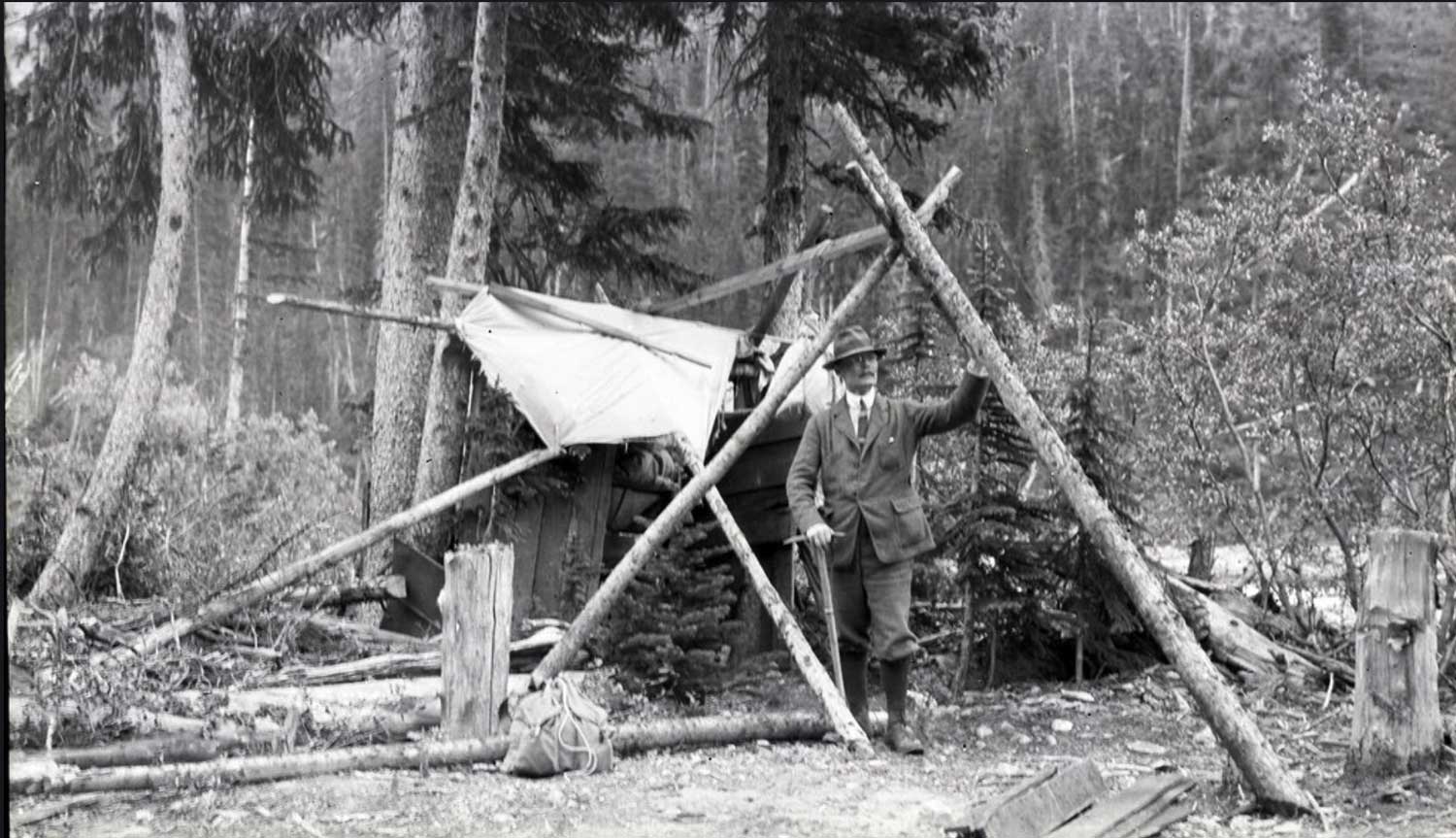Flows NE into Canoe Reach, Kinbasket Lake
52.6833 N 119.0667 W — Map 83D/11 — Google — GeoHack
Name officially adopted in 1974
Official in BC – Canada
The source is an unnamed glacier on the east slope of Mount Thompson.
The source is an unnamed glacier on the east slope of Mount Thompson.

Andrew James Gilmour standing in camp with an ice axe
AAC Gilmour Collection AJG.B4A7.048
American Alpine Club
In 1916, Gilmour took part in explorations of the peaks and glaciers north ofWhitehorn Mountain and west of Robson Pass, including the first ascent of Mount Longstaff.
With Newman Diefendorf Waffl [1879–1930] and Helen I. Buck [1884–1972], he made the first ascent of Mount Sir Alexander in 1929. Gilmour Glacier was named in 1947 by Raymond T. Zillmer [1887–1960].
Andrew Gilmour died in New York after an illness of nine months. By vocation a dermatologist, his avocation was travel and alpinism and for 30 years his activity ranged through the Alps, the Pyrenees, the American and Canadian Rockies, Wales and the Lake District, Mexico, the Cascades and the lesser peaks of the eastern United States.
Although his climbing interest manifested itself as early as 1905 with an ascent of the Gross Glockner, it was not until 1914 that it ripened with full-fledged mountaineering. That summer he joined and Holway and Frederic K. Butters in a month’s arduous back-packing trip in the southern Selkirks.
The close friendship thus formed between Holway and Gilmour led to further important explorations and first ascents: in 1915, of Mount Edith Cavell and the entirely unknown country at the headwaters of Small Creek and Horse Creek, with a nearly successful ascent of Mount Longstaff, and, in 1916, to the capture of the latter together with Mount Phillips, the approach being made from the Swiftcurrent Creek side.
These expeditions by Holway and Gilmour were personal “backpacking” enterprises into virgin territory. They were performed without Swiss guides or pack-trains, although an occasional horse might assist in the preliminary stage. Their main reliance was upon local men who helped to pack the party in and then acted in support by relaying provisions and sometimes by hunting game.
Dr. Gilmour was a member of the American, Canadian, Swiss and French Alpine clubs, the Explorers’ club, and the Appalachian cub. He was a fellow of the Royal Geographic society of London.
Association with Gilmour Glacier.
Origin of the name unknown.
Named is association with Mount Geikie.
Last summer another party, this time from the United States, Professor E. W. D. Holway, whose name figures prominently in Selkirk exploration, and Dr. A. J. Gilmour set out for the same goal and on August 5 reached [the summit of Mount Geikie], over the northwest arête, which they followed to a very steep cornice overhanging the perpendicular north face of the mountain. Several minor peaks at the hitherto unexplored sources of Geikie Creek were also ascended in the twelve days’ trip.
— Fay 1915
The feature was named by the Alberta-British Columbia Boundary Commission in 1921.
The feature was named by the Alberta-British Columbia Boundary Commission in 1921, in association with Gateway Peak.
While on the summit of Mt. Postern I made an interesting discovery, namely, that Gateway Glacier as shown on the Interprovincial Boundary Sheet No. 28, is not glacier at all, but a lake! This lake, which is of a beautiful jade colour appeared to be quite a bit larger than Icefall Lake and will, I hope, eventually take its place on the map as “Jade Lake.” It should be mentioned that Jade Lake lies a in a deep cirque between Mts. Portcullis and “Warden” and is invisible from any of the survey stations.
— Wates and Gibson
In 1911, Albreda postmaster Ernest C. Cox entered in his diary, “Saw Craig, the fire warden, Ed Garrett and Kennedy.” Edmund Garrett [1879–1958] built a house west of McBride in the 1910s (it burned down in 1982). He accompanied Roy Hargreaves on a 1932 hunting trip that included Hollywood producer Darryl Zanuck. Garrett was the first grader operator in the McBride highways district; he operated the blade while another man drove the four-horse team. Garrett married Minnie Redman (1873–1966), who had come to McBride as governess for the local superintendent of the Grand Trunk Pacific Railway. “Minnie was a weaver, a flowery writer who specialized in obituaries, and a master of elocution,” recalls Sadie Frye (Monroe). Ed and Minnie are buried in the McBride cemetery.